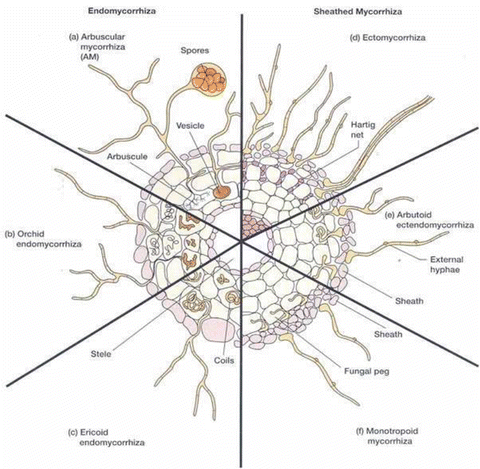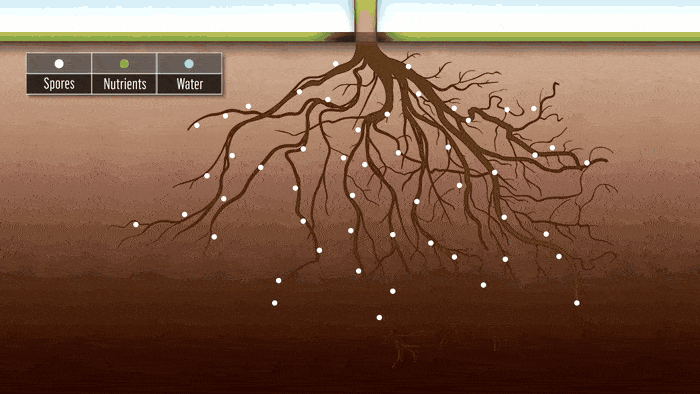
Extensive Fungal Root system
Mycoo is a intricate amalgam of Dormant Endo Classified Mycorrhizal Spores, Solanum extracts, Gelatine Substances, Microbial Grade Dextrose monosaccharide, Organic substances,
Ascorbic Acid & few other microbial supporting media. When Mycoo is Applied in the soil, Spores will germinate & establishes a mutual symbiotic association between Plant’s Root System & Fungi. These Mycoo colonies acts as extensive roots & Centuples the surface area of root system, which Results in more supply
of plant nutrients and water to all the crops. Mycoo Reduces the fertilizer dosages by min 25 - 30 %. Increases survival rate of Seedlings during the process of transplantation. Promotes drought resistance by increasing water holding capacity
of soil. Controls few fungal Diseases. And many more…..

That Bluish Lines Indicates Mycorrhizae
Benefits of Mycoo
-
Increases water holding capacity of soil
-
Increases nutrient holding capacity of soil
-
Increases porosity of the soil
-
Increases permeability of the soil
-
Provides microclimate in the soil
-
Enhances microbial activity in the soil
-
Improves nutrient cycle in the soil
-
Increases survival rate of the seedlings during transplantation
-
Increases root development
-
Reduces chemical fertiliser dosages
-
Improve soil structure
-
Reduces soil erosion
-
Enhances farming practices in sandy and rocky soils
-
Fights against root knot nematodes
-
Increases humus content of the soil
-
Increases surface area of the root system
-
Improves defence system of the crops
-
Bounds Soil particles together
-
Corrects micronutrient deficiencies in crops
-
Makes phosphorus more bio available to crops

Organic Certification Boards & Organisations From various Countries are Recommending that : Mycorrhizae needs to be applied 6,00,000 IP Per Acre for Proper Infestation of Fungi In one Acre Of Soil. If you Apply Less, Poor Infestation is of no use. Most of the Commercial brands in the market are giving 1 to 2,00,000 IP / Acre. Which is very less, that is of no use. We with the concern towards farmers, even in the tough conditions like application of Synthetic Fertilizers, Fungi needs to Infest. So we are giving 10,00,000 IP ( 1 Million IP ) in this 250 grams of Mycoo Product Which is more than enough for one acre.
Note : Weight of product is of no use with microbial products. Inoculum potential / Infectivity Potential ( IP ) Per Gram Powder / Liquid Is important. Total IP in the given Product is important.
Science Behind Mycoo

That whiteness indicates the Interconnected hyphae of mycoo Fungi which looks like a netted web ( Spiders )
Mycoo fights against
Root Knot Nematodes
mycorrhiza comes from Greek words. Myco means "fungus" and Rhiza means "root”
Myco - rrhiza = Fungal Root
This is a mutual symbiotic association between a fungus and a plant. Mycorrhizal fungi forms a mutualistic relationship with the roots of most of the plant species.
Sugars & water / mineral exchange :
plant makes organic molecules such as sugars by photosynthesis and supplies them to the fungus. In return, Fungi harvests Nutrients & water from soil with the help of extensive network of mycelial hyphae produced by the fungus and supply to the plant roots. It’s a mutualism.
the hyphae of endomycorrhizal fungi penetrate the cell wall and invaginate the cell membrane. hyphae penetrate plant cells, producing structures that are either balloon-like (vesicles) as a means of nutrient exchange.
-
Physically, most mycorrhizal mycelia are much smaller in diameter than the smallest root or root hair, and thus can explore soil material where plant roots and root hairs cannot reach, and provide a larger surface area for absorption of water & nutrients. For every cubic meter of soil, Mycoo fungi will send out more than 20,000 kilometres of hyphae
-
Chemically, the cell membrane chemistry of fungi differs from that of plants. they can secrete organic acids that dissolve or chelate many ions, or release them from mineral rocks by ion exchange.
-
Mycorrhizae have been found to release enzymes that are toxic to soil borne organisms such as parasitic nematodes.
-
defence responses are stronger in plants with mycorrhizal associations
-
mycorrhizal fungi connections can produce and receive warning signals. Specifically, when a host plant is attacked by an aphid, the plant signals surrounding connected plants of its condition. The host plant releases volatile organic compounds (VOCs) that attract the insect's predators. The plants c onnected by mycorrhizal fungi are also prompted to produce identical VOCs that protect the uninfected plants from being targeted by the insect.
-
hyphae of mycorrhizal fungi colonise the plant roots and helps in the uptake of soil mineral nutrients.
-
Mycorrhiza is a non-disease-producing association
-
About 90 percent of plants rely on mycorrhizal fungi, especially for mineral nutrients and in return the fungus receives sugars released by the plants.
-
When mycorrhizae are present, plants are less susceptible to water stress. Not only the fungal threads help to bring water and nutrition into the plant, but they also can store them for use when rainfall is sparse and temperatures are high.
-
Research is not sure to maintain natural mycorrhizal populations in soil. but in order to increase the amount of fungi, its better to apply mycoo once in every season.
How symbiosis happens ?
In forests, mycoo symbiosis happens naturally. Because of the microbial rich environment. But here in poor Farming fields, every season, we have to apply it. Mycoo spores should be incorporated into the soil before or during the planting. they can be top-dressed on the surface of seeds. Can be spouted, drenched or sent thru drip system Etc. Mycorrhizal spores germinate when in contact with plant roots and form filaments (hyphae), which spreads in soil same like plant root system.
-
Among the types of endomycorrhizal fungi, arbuscular mycorrhizal (AM) fungi are the most prevalent in soils.
- the long thread-like structure of the fungi acts as an extension of the plant’s root system and increases the plant’s access to essential nutrients, such as phosphorus, nitrogen, potassium, zinc and copper that would otherwise be available to the plant only when dissolved in water
-
plant root hairs can extend only one to two millimetres into the soil from the root. But the fungi create an invisible network of threads that explore a volume of soil extending up to 15 centimetres.
In addition to the provision of nutrients, other benefits to the plant include:
-
The mycorrhizal fungi threads, or filaments, promote drought resistance by enhancing the water holding capacity of soil. The outer walls of the filaments contain gluey compounds that cause fine particles of earth to clump together, building soil structure and making the ground less vulnerable to erosion.
-
The fungi selectively exclude the passive uptake of toxic elements limiting the partner plant’s exposure to heavy metals, such as lead and cadmium.
-
At high latitudes, high altitudes and other rocky environments, mycorrhizal fungi dissolve and take up nutrients from primary rock surfaces.
-
In boggy regions, the filaments buffer plant partners from the high acid content of peaty soils.
-
In saline ground, the fungi can protect their partner plants from high salt concentrations.
-
Mycorrhizal fungi can also protect plants from pests, like nematodes, and diseases both directly and by promoting plant vigour.
Over the last 60 years, mycorrhizal fungi have been depleted from soils where industrial agricultural practices have undervalued their significance as one of the components of soil health. Time has come to regenerate it. It’s every farmers responsibility to apply mycoo in the fields irrespective of crops.
Extra fungal roots means - extended feeding area
One of the most valuable organisms your soil can have is a fungus known as mycorrhizae
Mycorrhizae are actually a fungus. They exist as very tiny, almost or even entirely microscopic, threads called hyphae. The hyphae are all interconnected into a net-like web called a mycelium, which measures hundreds or thousands of miles—all packed into a tiny area around the plant.
Mycorrhizae can also serve as a sugar delivery service when plants shuttle sugar back and forth to different plants connected to the same common mycorrhizal network. Perhaps most bizarrely of all, the common mycorrhizal network can also serve as a means for plants to “talk” to each other—an Internet made out of fungus! This relationship between root systems and mycorrhizae is a true example of a win-win situation.
Finally, the hyphae continue to develop outside the roots forming an extended network of fine hyphae which cover up to 700 times more soil area than the plants own roots. This tangled network of fungal hyphae can reach a length of over 8000 kilometres, as a result, the fungus and the plant can together absorb much more water and nutrients than they can individually.
Maximum soil volume can be exploited by the plant with the help of mycorrhiza. Finally, fungi have higher surface-to-volume ratios than roots, which increases the rate at which nutrients are absorbed.
Building great soil structure :
Mycorrhizae also act as an important soil-binding agent, significantly contributing to friable soil texture. Their countless long filaments, called hyphae, tend to accumulate in the soil over a period of time and can persist for months or even years. Larger soil particles, particularly the sand-sized fraction, tend to be held together by these hyphae. The filaments tend to have sticky surfaces from extracellular polysaccharides, which are sugars processed and exuded by the mycorrhizae. Additionally, the tips of developing root hairs likewise secrete polysaccharidic mucigel, a similarly sticky, plant-produced substance. Together, these sticky materials enable the filamentous hyphae to strongly adhere to the soil particles, physically binding and enmeshing them together to form tiny, semi-stable aggregates. This aggregate structure increases in the root zone, encouraging further root growth, which in turn attracts more mycorrhizae, leading to more aggregation and so on, perpetuating the process.
many microbes produce ‘bio-glues’ that stick soil particles together and reduce erosion. Mycorrhiza is best of them.
The body of the mycorrhizal fungus consists of microscopic filaments called hyphae. An individual hypha (singular) is approximately 1/25th the diameter of a human hair
exceptions in using Mycoo :
-
When the soil already has such ideal nutrient and moisture levels that the plants can scavenge enough on their own.
-
with Brassicas (members of the mustard family), because they do not allow the mycorrhizal fungi to colonize their roots! Save your time and money!
-
when fungicides, pesticides, Fertilizers & any other agro chemicals are used in the field, please avoid using mycoo 15 days before & after using them.
Dear Farmers, please Add fungi to the soil 🙏
Mycoo acts as a A secondary root system for plants
Mycoo is a Hero of the landscape
Mycoo : An unsung hero of soil fungi
Mycoo fertilise the future soils
Nutrient trade :
With an increasing number of fungal traders, nutrients become “cheaper” to plants. This is what happens with mycoo


















Without mycoo
With using mycoo
Growth With & Without Mycoo ( Mycorrhiza )

That white roots are mycoo fungi



Without mycoo
With using mycoo









Root System is extended
food supply is extended
water supply is extended
bio mass is increased
yield is increased
quality is increased



Result of Mycoo Fungi
See this gif for 20 Seconds.
Spore germination & nutrients + water uptake by mycoo



Without mycoo
With using mycoo

With using mycoo
Without mycoo

Without mycoo
With using mycoo

